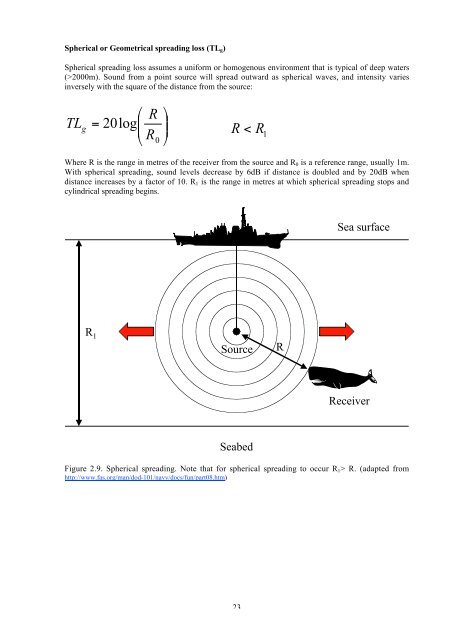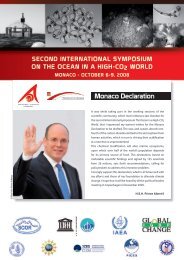- Page 2: Oceans of Noise 2004A WDCS Science
- Page 8 and 9: In the US, the deployment of Low Fr
- Page 10 and 11: its propagation beyond those declar
- Page 12 and 13: The best evidence for noise being f
- Page 14 and 15: Box 1. Characteristics of sound / l
- Page 16 and 17: Sound speed (c)The speed (c) of a w
- Page 18 and 19: Box 2. The effects of temperature,
- Page 20 and 21: 2.1.2. Measuring sound intensityIde
- Page 22 and 23: i.e. Equal pressure measurements di
- Page 28 and 29: 5.0 145Tug pulling loaded barge 1.0
- Page 30 and 31: The source used during 3-D surveys
- Page 32 and 33: Machinery noisePropulsion machinery
- Page 34 and 35: Man-made islands /caissonsFixed pla
- Page 36 and 37: 12 3245Drill bit6Figure 3.4. Sound
- Page 38 and 39: Transientnoise sourcesAircraftHelic
- Page 40 and 41: Results from the aerial surveys con
- Page 42 and 43: haemorrhaging in the inner ears and
- Page 44 and 45: However they also noted that whales
- Page 46 and 47: 4. The Use of Sound by CetaceansChr
- Page 48 and 49: seems logical, therefore, that if t
- Page 50 and 51: However, despite the reported low a
- Page 52 and 53: Kamminga and Wiersma 1981;Akamatsu
- Page 54 and 55: SongSocial callsShrieksSlaps0.03-80
- Page 56 and 57: anthropogenic factors that make the
- Page 58 and 59: 5.3 Longer-term impactsNoise is cle
- Page 60 and 61: 5.4 Indirect impactsThe above impac
- Page 62 and 63: decompression sickness (DCS) as see
- Page 64 and 65: 6. Examples of regional and nationa
- Page 66 and 67: 6.3 ASCOBANS and ACCOBAMSTwo region
- Page 68 and 69: implications and the discussion sho
- Page 70 and 71: 7.1. Consideration of Voluntary vs.
- Page 72 and 73: acoustic measurements have been mad
- Page 74 and 75:
7.6. Methods of protectionComplianc
- Page 76 and 77:
7.6.1 Monitoring7.6.1.1 Visual, aco
- Page 78 and 79:
Delory et al. (2002) use Ambient No
- Page 80 and 81:
8. ReferencesAburto, A., Rountry, D
- Page 82 and 83:
Caldwell, M.C., Caldwell, D.K., and
- Page 84 and 85:
Engas, A., Lokkeborg, S., Ona, E. a
- Page 86 and 87:
IWC 2002b. Report of the Scientific
- Page 88 and 89:
McCauley, R.D. 1994. Seismic Survey
- Page 90 and 91:
Potter, J. and Delory, E. 2001. Noi
- Page 92 and 93:
Smolker, R.A., Mann, J. and Smuts,
- Page 94 and 95:
Watkins, W.A. 1981b. The activities
- Page 96 and 97:
ANNEX 1The Application of Marine Po
- Page 98 and 99:
an important factor. 13 The judgeme
- Page 100 and 101:
in the preparatory work of the LOSC
- Page 102 and 103:
practice by the UNEP Governing Coun
- Page 104 and 105:
protection and preservation of the
- Page 106 and 107:
than international rules, standards
- Page 108 and 109:
Four of the twelve regional seas tr
- Page 110 and 111:
seismic operations in the Protocol
- Page 112 and 113:
ConclusionAt the global level, only
- Page 114 and 115:
Art 209 LOSC focuses on both standa
- Page 116 and 117:
No State Party may impose condition
- Page 118 and 119:
coastal States”. This formulation
- Page 120 and 121:
If the IMO makes this determination
- Page 122 and 123:
estrictions to vessels operating in
- Page 124 and 125:
In the EEZ, in comparison to the te
- Page 126 and 127:
Appendix A - Some international ins
- Page 128 and 129:
Convention for the Protection of th
- Page 130 and 131:
Available at:http://www.unep.ch/sea
- Page 132 and 133:
BucharestConventionArticle XIPollut
- Page 134 and 135:
environment1. The Contracting Parti
- Page 136 and 137:
- that under Article III.8.c) of AC
- Page 138 and 139:
e) no sudden or repeated change in
- Page 140 and 141:
Ref: Nowacek et al. 2001.Location:
- Page 142 and 143:
Location: Arctic• Vocal behaviour
- Page 144 and 145:
• Vaquita surfacing duration and
- Page 146 and 147:
• 6% of small delphinids (n=264;
- Page 148 and 149:
Species type: Boto, Inia geoffrensi
- Page 150 and 151:
• Humpback whales appeared tolera
- Page 152 and 153:
• Behaviour interpreted as aggres
- Page 154 and 155:
• There was no evidence of minke
- Page 156 and 157:
• Northern right whales may be ap
- Page 158 and 159:
• Migrating gray whales disturbed
- Page 160 and 161:
to Ensenada De La Paz, Mexico. Aqua
- Page 162 and 163:
distribution of humpback whales, Me
- Page 164 and 165:
Richardson, C.R. Greene, C.I. Malme
- Page 166 and 167:
Zhou, K., Pilleri, G. and Li, Y. 19
- Page 168 and 169:
6. surveys for Cuvier’s beaked wh




